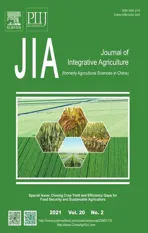Differences of yield and nitrogen use efficiency under different applications of slow release fertilizer in spring maize
2021-01-18LlGuanghaoCHENGGuigenLUWeipingLUDalei
Ll Guang-hao,CHENG Gui-gen,LU Wei-ping,LU Da-lei
Jiangsu Key Laboratory of Crop Genetics and Physiology/Jiangsu Key Laboratory of Crop Cultivation and Physiology/Agricultural College,Yangzhou University/Jiangsu Co-Innovation Center for Modern Production Technology of Grain Crops,Yangzhou 225009,P.R.China
Abstract Excessive or insufficient application of fertilizer has raised broader concerns regarding soil and environmental degradation.One-time application of slow release fertilizer (SF) has been widely used to reduce yield gap with potential maize yield and improve nitrogen use efficiency (NUE). A 2-year field experiment (2018–2019) was conducted to evaluate the effects of SF rates from 0 to 405 kg N ha–1 (named F0,SF225,SF270,SF315,SF360,and SF405) and 405 kg N ha–1 of common fertilizer(CF405) on the grain yield,biomass and N accumulation,enzymatic activities related with carbon–nitrogen metabolism,NUE and economic analysis. Results indicated that the highest grain yields,NUEs and economic returns were achieved at SF360 in both varieties. The enzymatic activities related with carbon–nitrogen metabolism,pre-and post-silking accumulation of biomass and N increased with increasing SF rate,and they were the highest at SF360 and SF405. The grain yield at SF360 had no significant difference with that at SF405. However,the N partial factor productivity,N agronomic efficiency and N recovery efficiency at SF360 were 9.8,6.6 and 8.9% higher than that at SF405. The results also indicated that the average grain yields,NUE and economic benefit at SF405 were 5.2,12.3 and 18.1% higher than that at CF405. In conclusion,decreasing N rate from 405 kg ha–1 (CF) to 360 kg ha–1 (SF) could effectively reduce the yield gap between realized and potential maize yields. The N decreased by 11.1%,but the yield,NUE and economic benefit increased by 3.2,22.2 and 17.5%,which created a simple,efficient and business-friendly system for spring maize production in Jiangsu Province,China.
Keywords: spring maize,grain yield,slow release fertilizer,nitrogen use efficiency,economic benefit
1.lntroduction
Maize (Zea maysL.) is a major food crop in China. It is of great significance for the sustainable development of Chinese agriculture to realize the coordination of high yield and high efficiency of maize. With the development of green agriculture,reducing the gap with crop potential yield and increasing nutrient use efficiency simultaneously is challenging due to the increasing demand for food and intensifying environmental issues (Chenet al.2014; Yuet al.2015). In China,farmers often applied excessive fertilizer to get high yield (Yanget al.2018). The annual fertilizer consumption of China accounts for 35% of the world (Ahmedet al.2017). However,application of excessive fertilizer did not reliably maintain the expected yield and reduced NUE(Chenet al.2011; Menget al.2016),and severely degraded the agricultural and ecological environment (Lal 2013; Zhouet al.2016). Thus,efficient fertilizer management based on application rates matched to crop demand is a critical practice to increase crop productivity while avoiding nutrient losses and environmental degradation.
Nitrogen is the most limiting nutrient for agricultural production worldwide and application of N fertilizer is generally required for optimum yield of most crops.Application of slow release fertilizer (SF) as an alternative to multiple N application timings has been pursued internationally (Zhanget al.2001; Liet al.2017a). The N release rate of SF corresponds more closely to crop plant N requirements for physiological functions (Liet al.2020a). Its one-time application is also more convenient than multiple N applications. In addition to reduce labor inputs,SF can effectively improve maize yield and NUE (Zhaoet al.2013;Zhenget al.2017). Improvements in maize grain yield are associated with increases in biomass (Ciampitti and Vyn 2011,2012),and plant N uptake is closely linked with biomass and grain yield (Setiyonoet al.2010; Ciampitti and Vyn 2011). Rational N rates could increase post-silking N accumulation,meet high yield demands and increase NUE (Menget al.2016). The post-silking N uptake of SF was higher than that of conventional urea (Huet al.2013).The SF application could increase net photosynthesis and reduce NH3volatilization by enhancing the enzymatic activities that were related with carbon–nitrogen metabolism,which increased maize yield and NUE (Zhaoet al.2013; Liet al.2017b). Genget al.(2016) and Zhenget al.(2017)revealed that the release curves of slow release urea in the field correspond well to the N requirement of maize plants,which promoted biomass and N accumulation and produced higher grain yield and NUE compared with common urea.
The spring maize region in Jiangsu Province,China is predominantly rain-fed and the conventional N rate of common fertilizer (CF) is about 405 kg ha–1for achieving high grain yield (Wanget al.2019; Liet al.2020b),but N application varies greatly among individual farmers (Zhanget al.2018). The effect of N rate on maize have been widely investigatedviadetailed physiological analyses (Muchow 1994; Rossiniet al.2011) that mainly focused on yield or N uptake and allocation dynamics (Ciampitti and Vyn 2011,2013a,b). An improved understanding on the response of both maize grain yield and NUEs to N inputs is critical in the economically and environmentally sustainable development of cropping systems in Jiangsu Province. Our group has recommended the appropriate density of 75 000 plants ha–1combined with one-time application of 405 kg N ha–1SF to increase maize yield and NUE (Liet al.2020a,b).The objective of the present study is to evaluate the effects of decreasing SF rate on aboveground biomass and N accumulation,enzymatic activities related with carbon–nitrogen metabolism,grain yield,NUEs,and economic return. The results could provide theoretical and technical supports on reducing yield gap with maize potential yield and increasing efficiency and revenue.
2.Materials and methods
2.1.Experimental materials and design
A field study was conducted at the Jiangxinsha Farm,Nantong,Jiangsu Province,China (31°48´N,121°06´E) in 2018 and 2019. The average temperatures were 22.3 and 23.1°C,while total sunlights were 657.8 and 849.2 h,and average rainfalls were 348.1 and 559.1 mm from planting to grain harvest in 2018 and 2019 (Fig.1). The soil type was sandy loam and the average organic matter,total N,alkali hydrolyzable N,exchangeable P,and available K were 11.82 g kg–1,0.97 g kg–1,79.2 mg kg–1,5.95 mg kg–1,and 61.01 mg kg–1in 2018,9.16 g kg–1,1.12 g kg–1,81.3 mg kg–1,7.36 mg kg–1,and 72.16 mg kg–1in 2019. The concentrations of N,P2O5and K2O were 27,9 and 9% in SF and were 15,15 and 15% in common compound fertilizer,respectively. The concentration (%) of N was 46 in urea.All fertilizers were provided by Jiangsu Zhongdong Fertilizer Co.,Ltd.(Changzhou,Jiangsu,China). Treatments were arranged in a split plot design in both years. The main plot was assigned with two varieties,Suyu 30 (SY30) and Jiangyu 877 (JY877). The subplot was fertilizer application,including no fertilizer (F0),225 (SF225),270 (SF270),315 (SF315),360 (SF360),and 405 (SF405) kg N ha–1of SF,and 405 kg N ha–1common fertilizer (CF405). The SF was one-time application at sowing stage,and CF405 was applied 135 kg N ha–1common compound fertilizer at sowing stage,225 kg N ha–1urea at jointing stage and 45 kg N ha–1urea at silking stage). At the same time,the applied rates of P2O5and K2O were 0,75,90,105,120,135,and 135 kg ha–1,respectively. The plant density was 75 000 plants ha–1. All plots were 45 m long and 3.6 m wide with double rows (wide and narrow rows spacing were 0.8 and 0.4 m,respectively).
Maize varieties SY30 and JY877,which are widely planted in Jiangsu Province,were used as the test materials.Seeds were sown at a depth of 3–5 cm on April 2 in 2018 and 2019. The harvest dates were August 6 in 2018 and 2019. The depth of furrow fertilization was 10 cm. Other field management followed farmer’s conventional practices.
2.2.Sampling and measurements
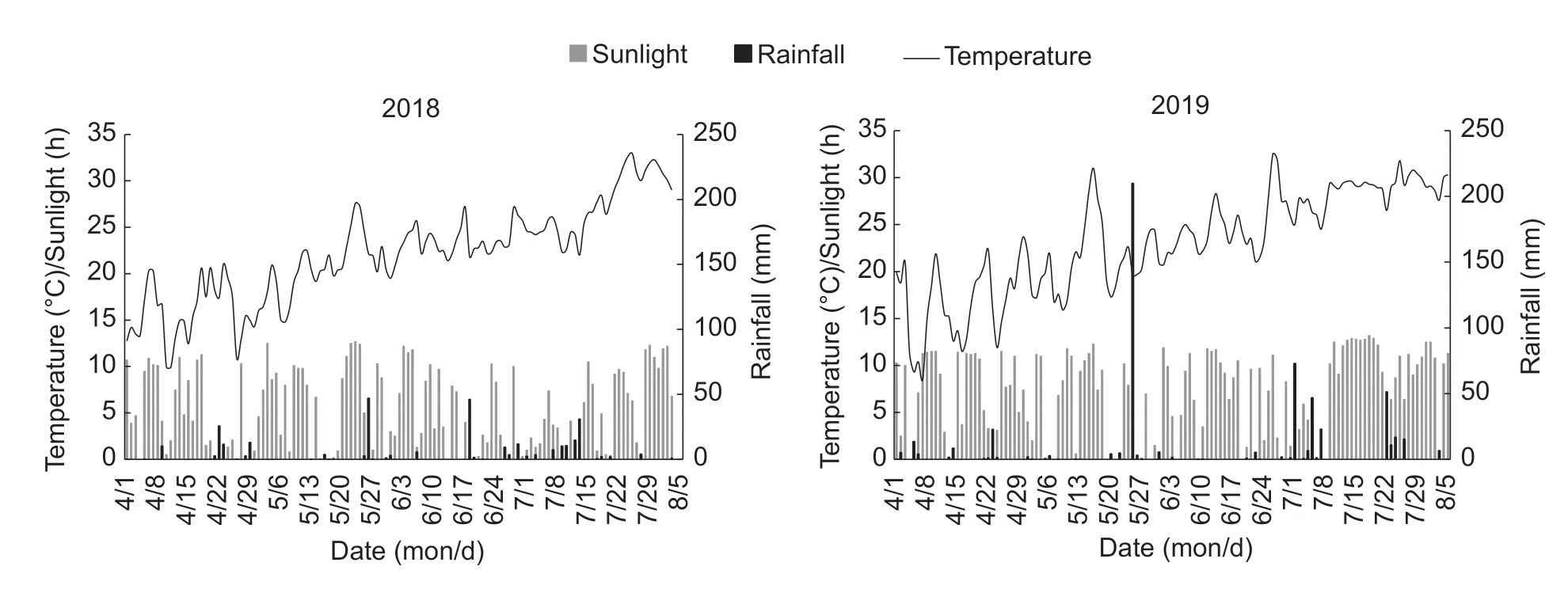
Fig.1 Daily sunlight,rainfall and average temperature for the growing season from planting to harvest in 2018 and 2019.
Three plants were collected as the representative for each treatment at the silking stage (R1) and maturity stage (R6)in the field experiment. Aboveground plants were separated into leaves and stems at R1 and into stems,leaves,cobs,and grains at R6. Then samples were dried to constant weight at 80°C in a forced-air oven. After weighing,the samples were ground using a cyclone sample mill with a fine mesh (0.5 mm). Three representative plants were sampled from each treatment at R1 and milk stage (R3) to determine the enzymatic activities (phosphopyruvate carboxylase(PEPC),ribulose-1,5-bisphosphate carboxylase (RUBPC),nitrate reductase (NR),and glutamine synthetase (GS) in the ear leaf using enzyme-linked immunosorbent assay(ELISA) (Liet al.2017b; Asiyeet al.2019).
The N concentrations of different organs were measured using the micro-Kjeldahl method (CN61M/KDY-9820,Beijing,China; Liet al.2020b). The following parameters(Ciampittiet al.2012; Qiuet al.2015; Liet al.2020b) were calculated:
Plant N accumulation amount (kg ha–1)=Plant N concentration×Plant dry weight
Post-silking N accumulation amount (kg ha–1)=Total N accumulation amount at maturity−N accumulation amount at silking
N partial factor productivity (PFPN,kg kg–1)=Grain yield in N application treatment/Total amount of applied N
N agronomic efficiency (AEN,kg kg–1)=(Grain yield in N application treatment–Grain yield in N0)/Total amount of applied N
N recovery efficiency (REN,%)=(Total plant N uptake in N application treatment−Total plant N uptake in N0)/Total amount of applied N
2.3.Grain yield determination
Thirty ears from the middle rows of each plot were harvested at R6 using a continuous sampling method and were used to determine yield and yield components (standard moisture content was 14%).
2.4.Economic analysis
Cost-profit analysis was performed according to Thompsonet al.(2000) and Guoet al.(2017).
Net return=Grain yield×Grain price–Cost (total)
Cost (total)=Cost (N fertilizer)+Cost (topdressing)+Cost(others)
Cost (others)=Cost (plowing)+Cost (harrow)+Cost (seed)+Cost (sowing)+Cost (herbicide)+Cost (insecticide)+Cost(harvest)
The grain price is 1.8 CNY kg–1in 2018 and 2019,and the SF,CF and urea price is 2.3,2.0 and 2.0 CNY kg–1.The costs of plowing,harrow,seed,sowing,herbicide,insecticide,and harvest were 675,300,225,750,195,225,and 750 CNY ha–1,respectively.
2.5.Statistical analysis
All data were subjected to ANOVA in the General Linear Model module of SPSS (ver.17.0,SPSS,Chicago,IL,USA).Comparisons among treatments were based on Duncan’s test at the 0.05 probability level (P<0.05). Figures were generated with the Sigma Plot 10.0 Program.
3.Results
3.1.Grain yield response to N rates
Fertilizer rate affected the grain weight,number and yield significantly (P<0.01) (Table 1). The relationships between SF application and grain yield of two varieties were shown in Fig.2. In 2018 and 2019,the grain yields of two varietiesgradually increased with increasing N rates. The grain yield at SF360 was increased by 31.1,22.8 and 13.2% than SF225,SF270 and SF 315 in SY30,by 30.9,20.5 and 10.8%in JY877,respectively,but had no significant difference with SF405. The average grain yield of both varieties at SF405 was increased by 5.2% than that at CF405. The highest grain yields (12 030 and 12 974 kg ha–1) were obtained at SF405 in JY877. The grain numbers and weight gradually increased with increasing N rates below 360 kg ha–1,but those two parameters had no significant difference between
SF360 and SF405. The average grain yield in 2019 was significantly higher than that in 2018,probably because the climate in 2019 was more favorable for maize growth.
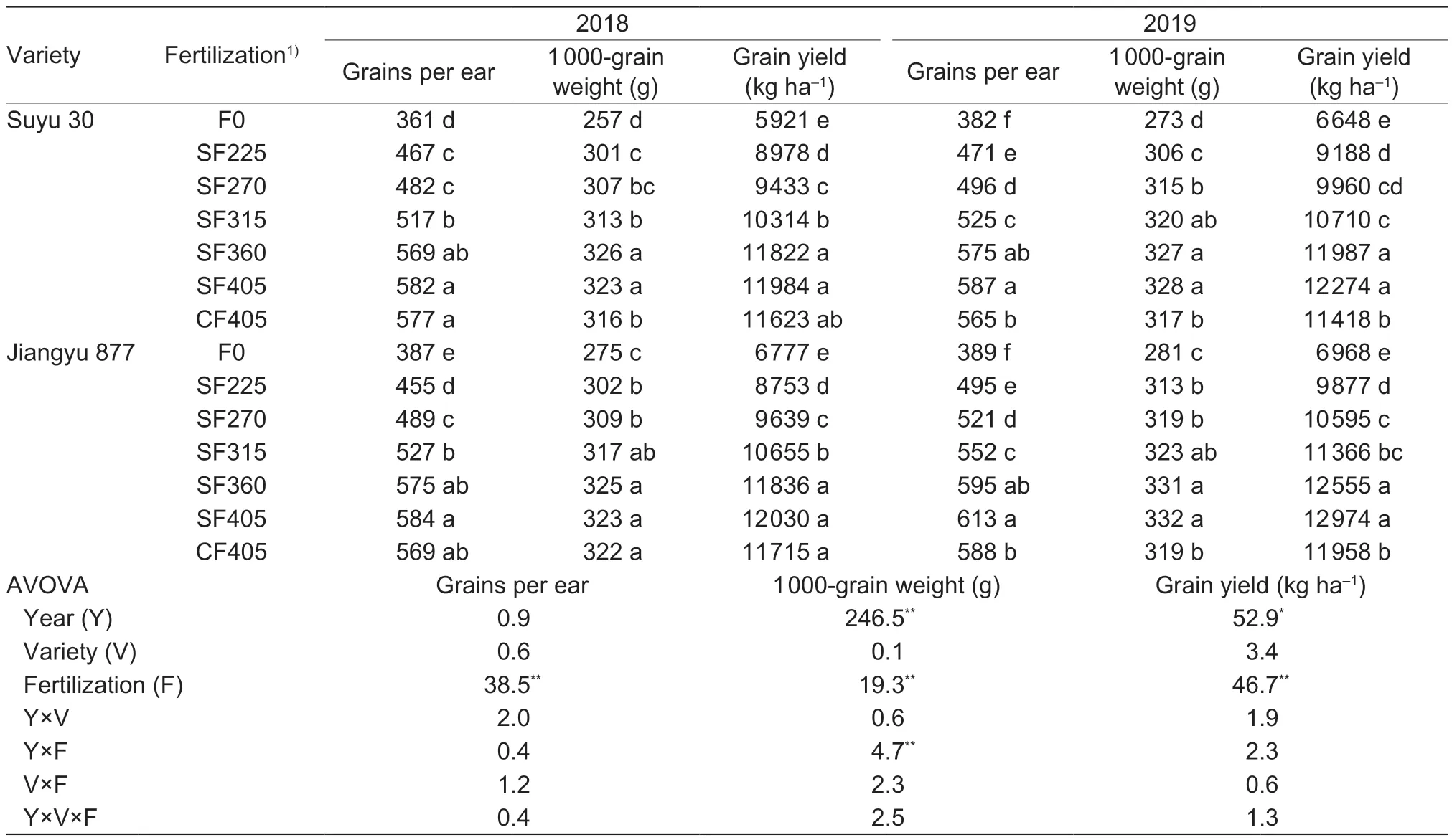
Table 1 Effects of slow release fertilizer (SF) rates on grain yield and yield components in spring maize
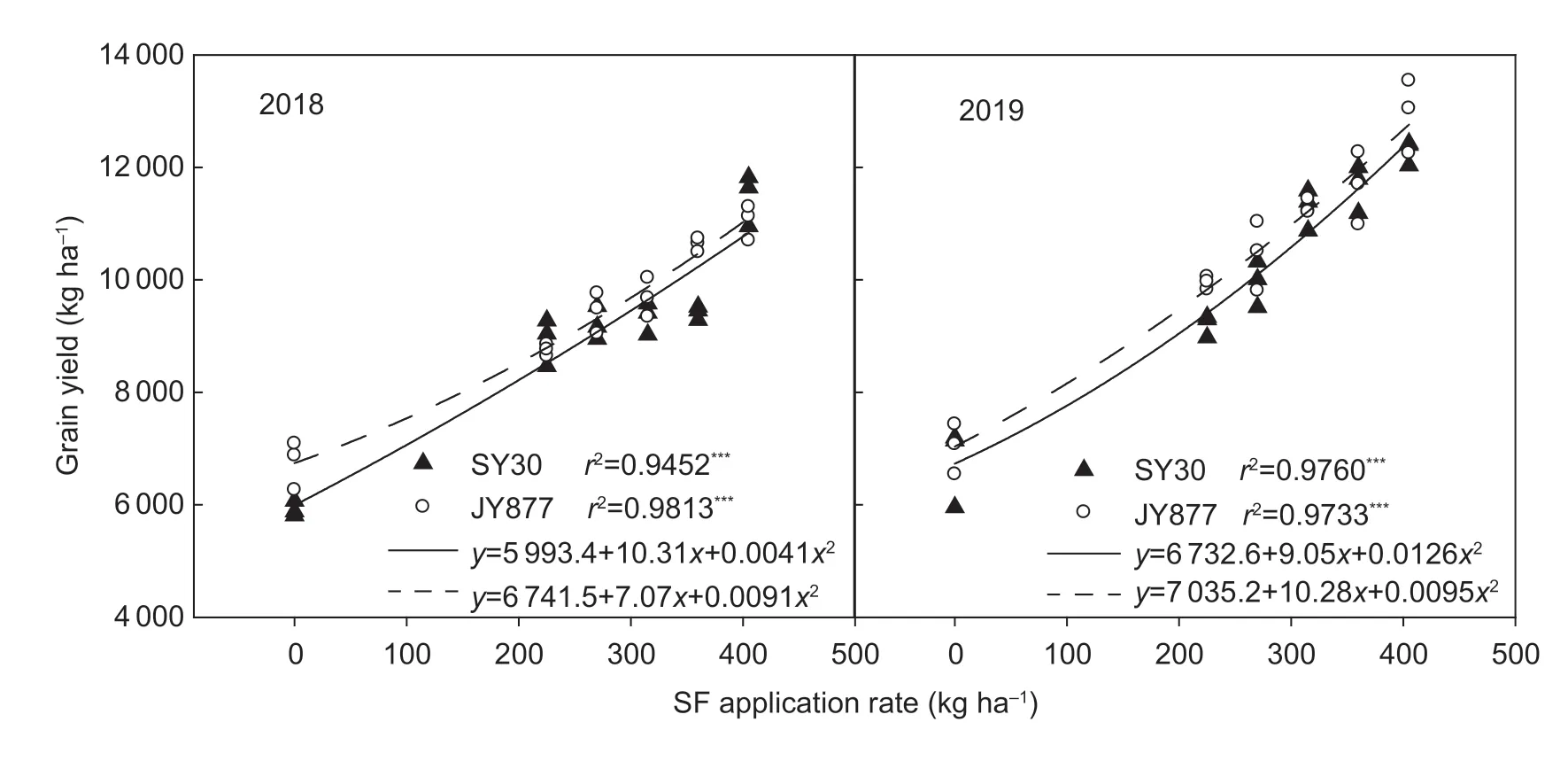
Fig.2 Relationship between slow release fertilizer (SF) rates and maize grain yield. SY30,Suyu 30; JY877,Jiangyu 877. ***,significant difference at the 0.001 probability level.
3.2.Aboveground biomass and N accumulation
Fertilizations had significant effects on total,pre-and postsilking biomass accumulation (P<0.05) (Fig.3). The different total biomass primarily created by differences in post-silking.The total biomass increased with the increase of SF rates.In 2018,SF405 had the highest biomass at both SY30 and JY877,and those at SF360 and CF405 had no significant difference. The pre-silking biomass at SF360,SF405 and CF405 had no significant difference. However,the post-silking biomass at SF405 was significantly higher than the other treatments. In 2019,the biomass not different between SF360 and SF405,and both were higher than those at CF405; the post-silking biomass at SF360 and SF405 had no significant difference and they were significantly higher than those at the other treatments.
A significant difference in N uptake between the fertilizer rates was observed in 2018 and 2019 (Fig.4). The aboveground N uptake increased with the increasing SF rate. Pre-and post-silking N uptake for SF360 and SF405 were significantly higher than other treatments. The pre-and post-silking N uptake for CF405 were lower than SF360 and SF405,but significantly higher than other treatments. The differences in total N uptake primarily created by differences in post-silking.
3.3.Enzymatic activities of PEPC and RUBPC
Fertilizations had significant effects on the activities of PEPC and RUBPC which were involved in leaf carbon metabolism (P<0.05),while there were no significant differences between years and varieties on PEPC,and the year and variety had significant effects on RUBPC at R1 (Table 2). In 2018 and 2019,the activities of PEPC and RUBPC decreased from R1 to R3,and increased with the increasing SF rates in both varieties. The activities of PEPC and RUBPC had no significant differences between SF360 and SF405 at R1 and R3,and they were significantly higher than those at the other treatments. Activities of PEPC and RUBPC at SF405 were higher than those at CF405.
3.4.Enzymatic activities of NR and GS
Fertilization had significant effects on the activities of NR and GS which were involved in leaf N metabolism (P<0.05),while there were no differences between years and varieties on GS,and the year had significant effects on NR (Table 3).The activities of NR and GS decreased from R1 to R3,and those under fertilization were higher than those at F0. The average activities of NR at SF405 increased by 3.8,20.9,37.7,and 11.8% than those at SF315,SF270,SF225,and CF405 at R1,and by 11.2,24.8,37.3,and 7.9% at R3.The average activities of GS at SF405 increased by 6.5,13.0,29.8,and 5.1% than those at SF315,SF270,SF225,and CF405 at R1,and by 4.2,10.4,25.5,and 5.2% at R3.The SF360 and SF405 had similar activities of NR and GS at R1 and R3,and they were significantly higher than the other treatments.
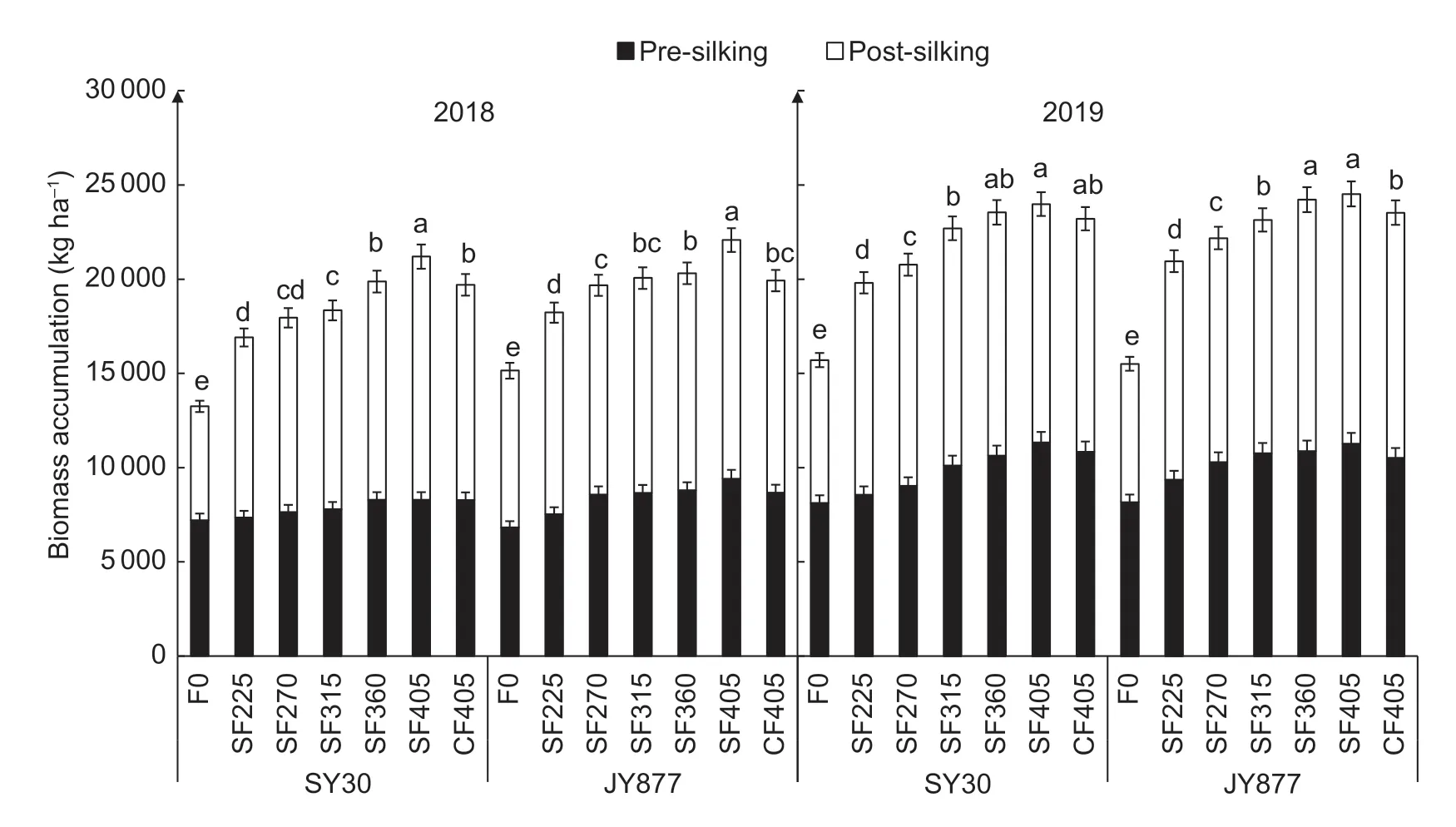
Fig.3 Effects of slow release fertilizer (SF) rates on biomass accumulation of spring maize. SY30,Suyu 30; JY877,Jiangyu 877.F0,no fertilizer; SF225,SF270,SF315,SF360,and SF405,N application rates of slow release fertilizer were 225,270,315,360,and 405 kg ha–1,respectively; CF405,N application rate of common fertilizer was 405 kg ha–1. Bars mean SE (n=3). Different letters above the bars in each variety are significantly different at 5% probability level.
3.5.Nitrogen use efficiency
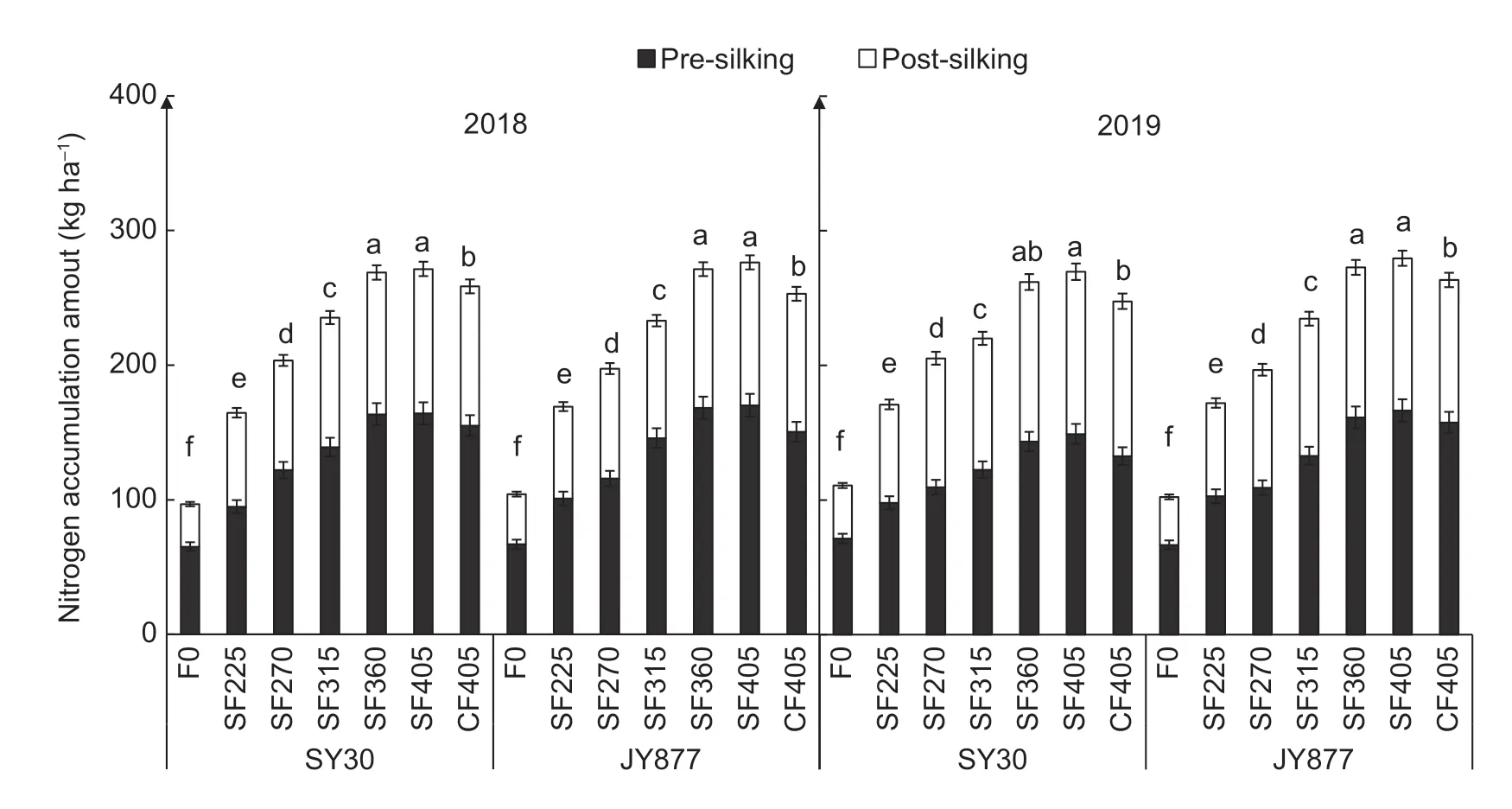
Fig.4 Effects of slow release fertilizer (SF) rates on nitrogen (N) accumulation of spring maize. SY30,Suyu 30; JY877,Jiangyu 877.F0,no fertilizer; SF225,SF270,SF315,SF360,and SF405,N application rates of slow release fertilizer were 225,270,315,360,and 405 kg ha–1,respectively; CF405,N application rate of common fertilizer was 405 kg ha–1. Bars mean SE (n=3). Different letters above the bars in each variety are significantly different at 0.05 probability level.
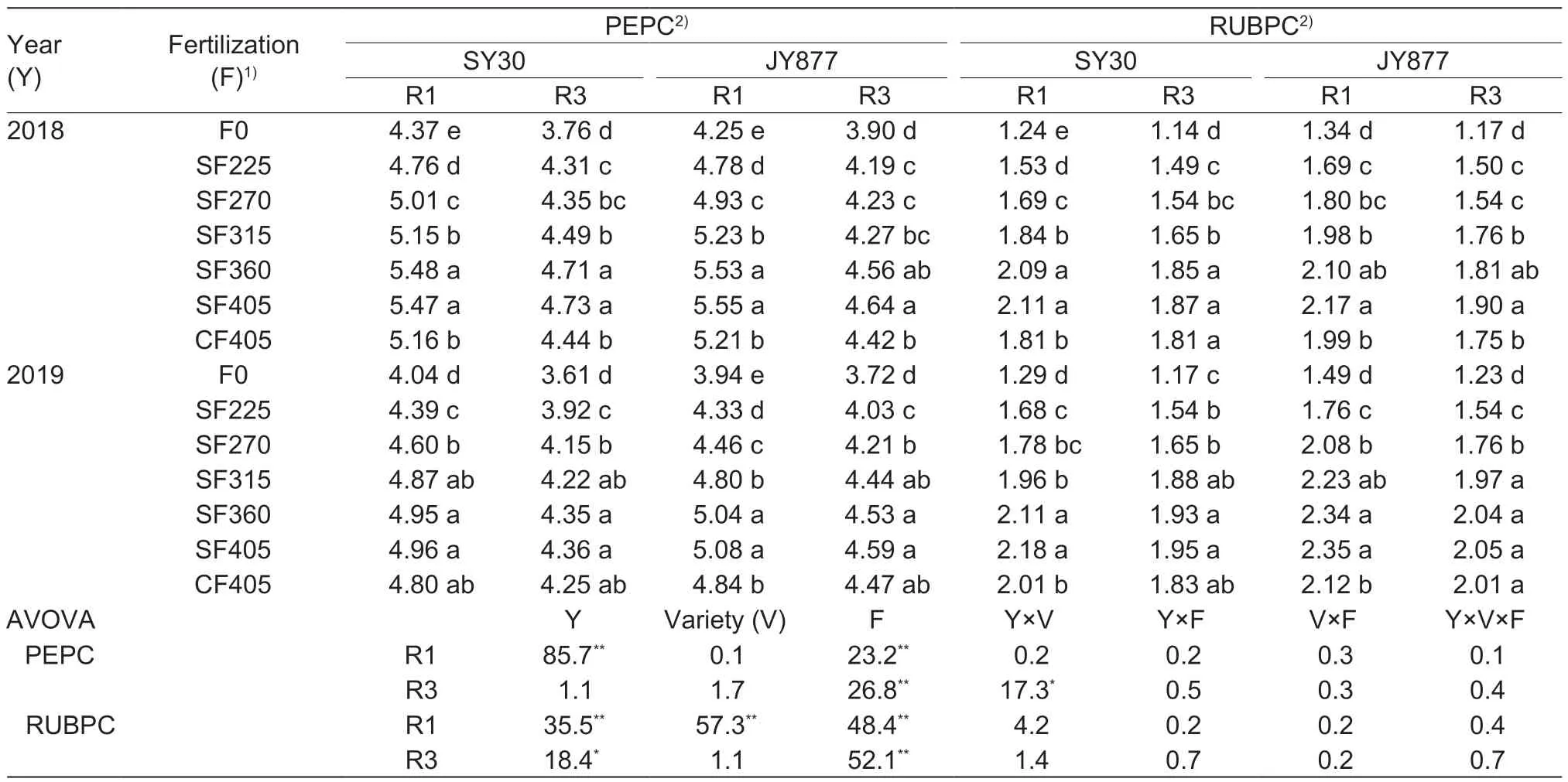
Table 2 Effects of slow release fertilizer (SF) rates on phosphopyruvate carboxylase (PEPC) and ribulose-1,5-bisphosphate carboxylase (RUBPC) activities (IU g–1 FW) in spring maize ear leaf
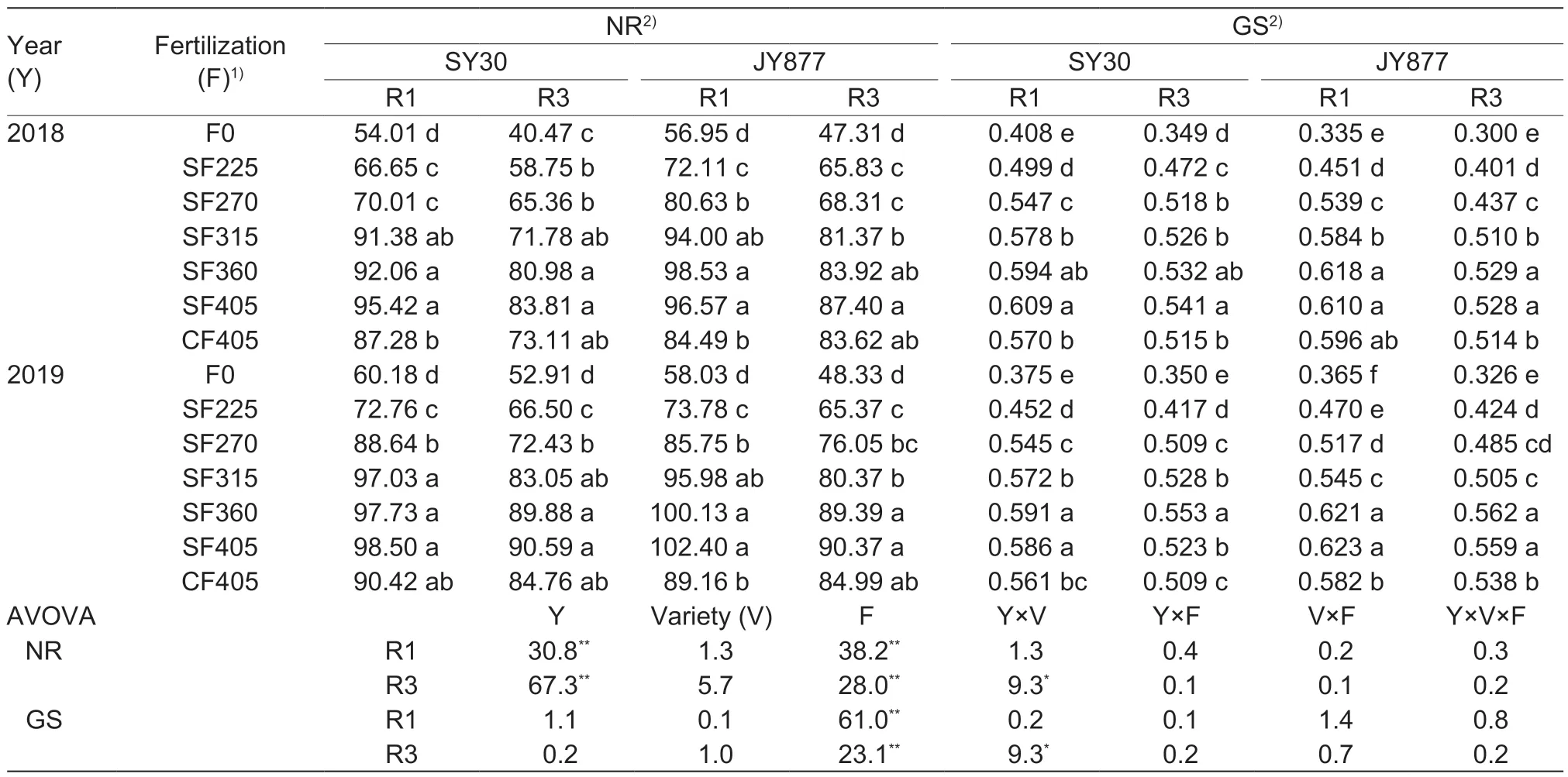
Table 3 Effects of slow release fertilizer (SF) rates on nitrate reductase (NR) and glutamine synthetase (GS) activities (IU g–1 FW)in spring maize ear leaf
Fertilization had significant effects onPFPN,AENandREN. The year had significant effects onPFPNand had no significant effect onAENandREN. The variety had significant effects onPFPNandAEN,but had no significant effect onREN(Table 4).PFPNdecreased with the increasing SF rate,but SF315 and SF360 had similarPFPNin both varieties in 2018 and 2019.AENincreased with the increasing SF rate,but the averageAENat SF360 was 8.1 and 5.1% higher than those at SF405 in SY30 and JY877,respectively. TheRENhad similar trend withAEN.The averagePFPN,AENandRENat SF360 increased by 9.8,6.7 and 8.9% than those at SF405. The averagePFPN,AENandRENat SF405 were 5.2,12.7 and 12.3% higher than those at CF405.
3.6.Correlation analysis
The correlation coefficients of carbon–nitrogen metabolism enzymatic activities,biomass and N accumulation with grain yield and its components were shown in Table 5.The activities of PEPC and RUBPC at R1 had a positive correlation with post-silking biomass accumulation. The activity of NR at R1 was positively correlated to post-silking N uptake. The activities of RUBPC and NR at R1 had a positive correlation with grain yield and its components.The post-silking biomass and N accumulation,1 000-grain weight and grains per ear also had significantly positive correlations with grain yield.
3.7.Economic evaluations of different treatments
The gross returns,costs and net returns of different treatments were shown in Table 6. The costs increased with the increasing SF rates. Meanwhile,the cost of topdressing at CF405 was 1 800 CNY ha–1. The SF360 and SF405 showed greater economic benefit among all the treatments in both years,while fertilizer and variety had significant effects on gross return and net return. The average gross return and net return in JY877 were 3.8 and 5.5% higher than those of SY30,respectively.
4.Discussion
4.1.Grain yield response to fertilization
Large regional variations in maize yield using the same cultivar and management measures occur due to climate diversity (Heet al.2020). A previous study has demonstrated that 210 kg N ha–1induces optimum biomass accumulation and allocation to grains to achieve optimum grain yield and NUE in the North China Plain (Qiuet al.2015). In the present study,the highest grain yield and NUEs were achieved under 360 kg N ha–1of SF. Previous studies showed that the response of maize grain yield to increasing N rates follows a parabolic curvilinear relationship (Abbasiet al.2013; Qiuet al.2015). Increasing N application rates could increase grain number and weight in maize production (Rossiniet al.2011; Liet al.2018). In this study,the grain numbers and weight gradually increased with increasing SF rates and peaked at SF360 and SF405. The SF rates between 360 and 405 kg N ha–1had similar grain yields. SF405 had higher grain yield than CF405 and the results were consistent with the previous studies (Zhaoet al.2013; Donget al.2016).
4.2.Carbon–nitrogen metabolism response to fertilization
PEPC and RUBPC in maize ear leaf involved in CO2fixation and were closely related to photosynthetic production capacity,which is a key factor in determining maize grain yield (Liuet al.2018b; Asiyeet al.2019). Proper fertilization could increase the photoassimilate and promote the biomass accumulation (Hernándezet al.2015; Liet al.2020a). NR and GS were the key enzymes involved in crop nitrogen metabolism,and their activities were closely related to the ability of soil fertilizer supplying (Singletaryet al.1990;Singaram and Kamalakumari 2000; Liet al.2017b). N rate is closely related to N uptake,translocation,and partitioning in maize (Ciampitti and Vyn 2011; Chenet al.2015; Menget al.2016). Aboveground N uptake increased with N rate primarily due to the increased aboveground biomass (Liuet al.2018a). Our results indicated that the enzymatic activities related with the carbon–nitrogen metabolism increased with increasing SF rates,as well as the pre-and post-silking biomass and N accumulation. SF treatments of360 and 405 kg N ha–1had similar activities,biomass and N accumulations,and they were significantly higher than those of CF405. This is consistent with the result of the previous study that SF could drastically promote the remobilization of N from vegetative organs to the grain between the vegetative and the reproductive stages (Liet al.2017a).
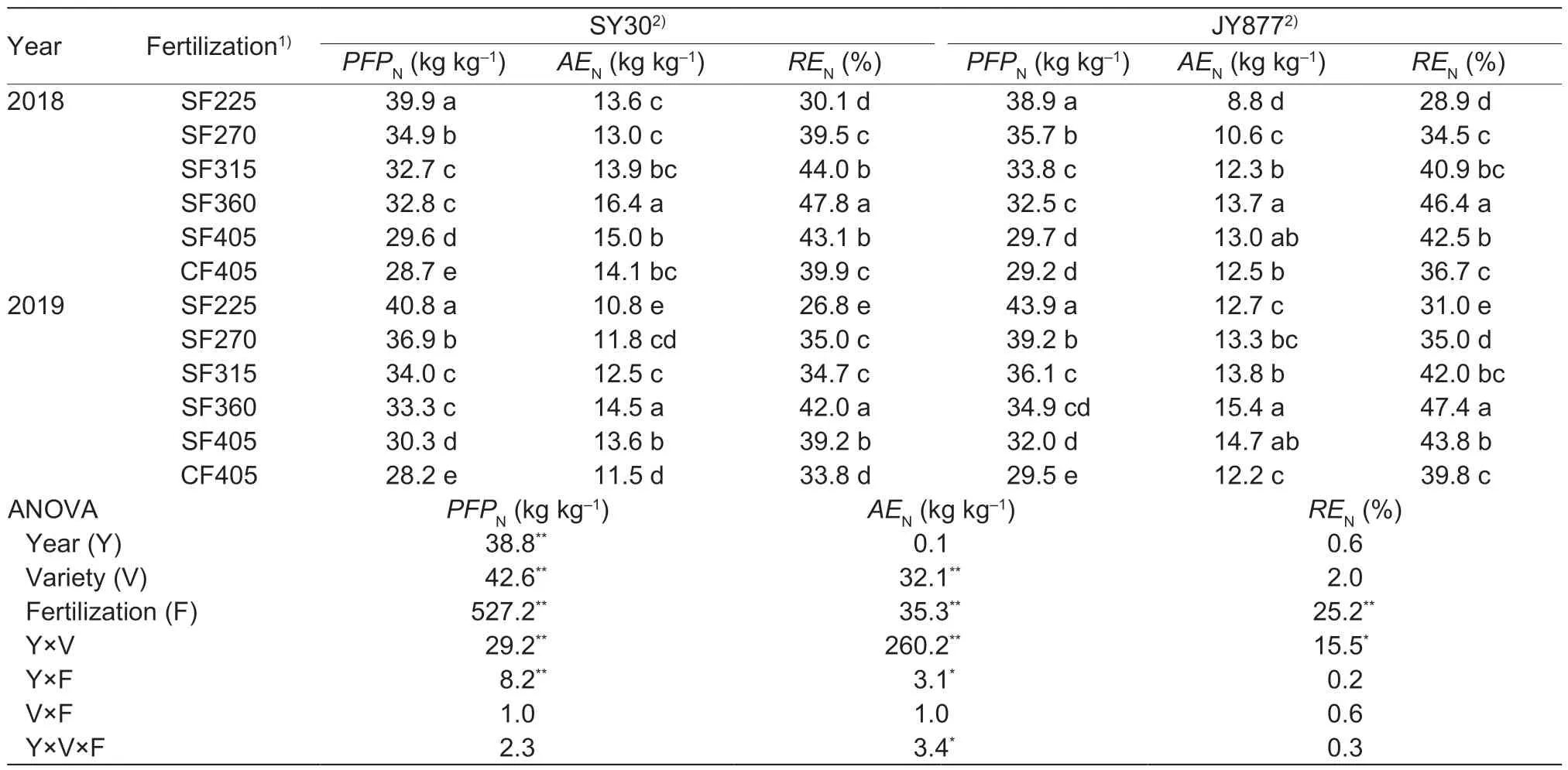
Table 4 Effects of slow release fertilizer (SF) rates on nitrogen (N) use efficiencies of spring maize

Table 5 Correlation analysis related to fertilizer application rates
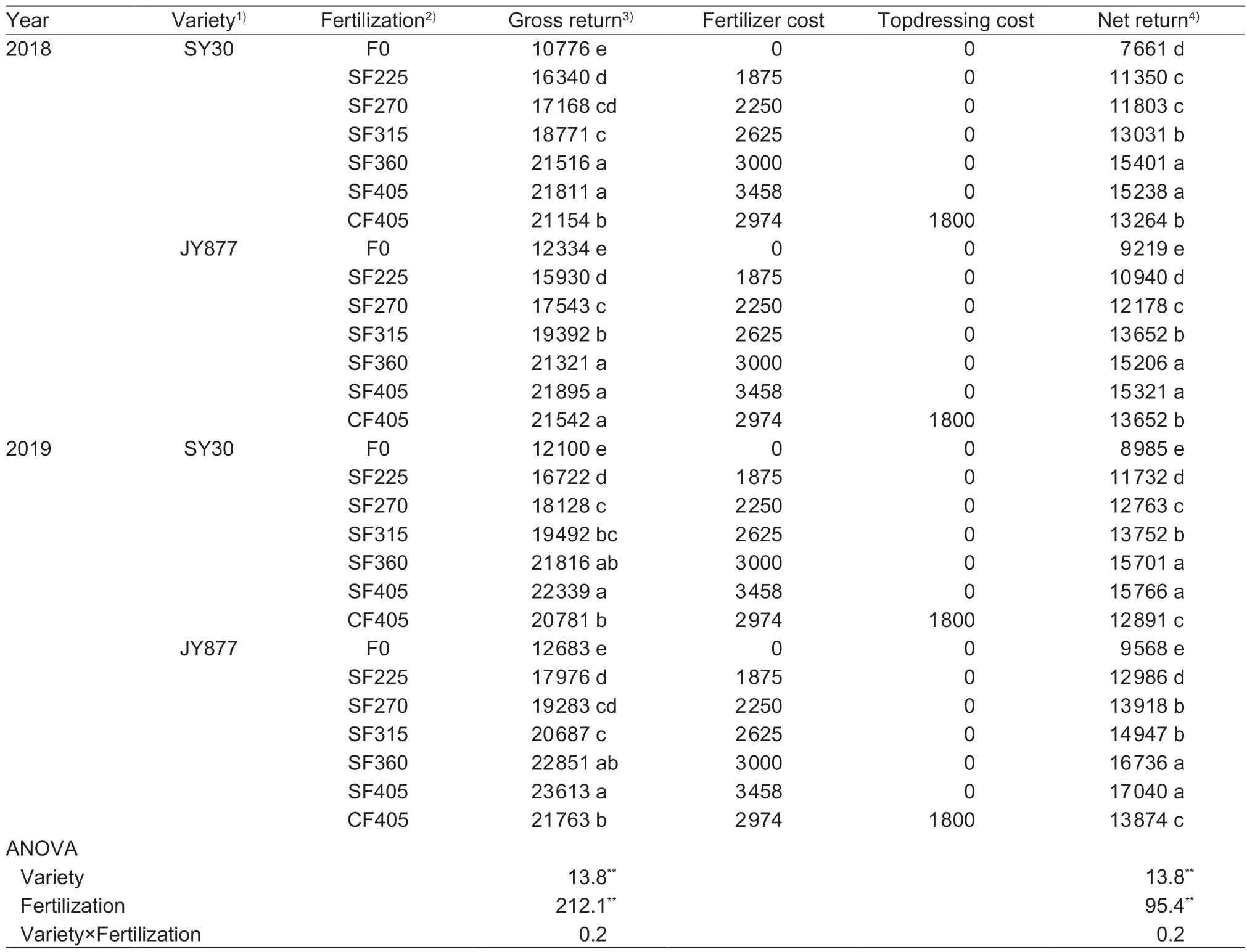
Table 6 Economic analysis (CNY ha–1) related to slow release fertilizer (SF) rates in 2018 and 2019
4.3.NUE response to fertilization
The various assessments of NUEs are affected by the complex interaction of environment,management practices and crop genotype and are important to environmental sustainability and profitability (Ciampitti and Vyn 2011).Fertilizer management was one of the key factors that were related to nutrient utilization in maize production (Mutukuet al.2020). Low fertilizer rates may produce high NUEs,but result in high yield gap with crop potential yield and low efficient use of land,water and other production inputs(Ciampitti and Vyn 2011; Abbasiet al.2013). Whereas excessive fertilization often reduced NUEs,because crop N utilization will be limited by biotic and abiotic constraints other than N supply (Qiuet al.2015). In the present study,thePFPNdecreased with increasing SF rates,but that was similar between SF360 and SF315. TheAENandRENincreased with increasing SF rates from SF225 to SF360,but those of SF360 were higher than SF405. Moreover,thePFPN,AENandRENof SF405 were significantly higher than those of CF405. These results indicated that SF was superior to CF in improving NUEs under same N rate,which was consistent with previous studies that appropriate onetime application of SF could increase grain yield and NUE than CF in maize production (Zhaoet al.2013; Liet al.2020b).
4.4.Economic return response to fertilization
Farmers also considered the economic risks and benefits based on the fertilizer and grain prices when the SF was used (Farmaha and Sims 2013). The high cost but laborsaving element of SF may be a trade-off in terms of practical production (Hyattet al.2010; Guoet al.2017). Our data showed that cost of CF was lower than that of SF at the same rates,but the net return of SF was significantly higher than that of CF because of the advantage of increased grain yield and decreased labor costs with one-time application.On the other hand,the net return would not decrease with the decrease of SF rate from 405 to 360 kg N ha–1. Based on the present results,the SF rate of 360 kg N ha–1would be an economical choice for high-yielding and -efficiency spring maize system in Jiangsu Province.
5.Conclusion
Under the same N rate (405 kg ha–1),the SF was superior to CF in increasing maize yield and NUE. Reducing N application rate of SF by 11% from 405 to 360 kg ha–1increased NUE,but the enzymatic activities related with carbon–nitrogen metabolism,the biomass and N accumulation,grain yield,and economic return were unaffected. However,reducing N rate of SF from 405 to 315 kg ha–1or more significantly decreased yield and economic return. Decreasing N rate from 405 kg ha–1(CF)to 360 kg ha–1(SF) could ensure stable yield production and increase NUE and economic benefit by 22.2 and 17.5%. In conclusion,the suitable N application rate of SF in Jiangsu spring maize production is 360 kg ha–1.
Acknowledgements
We would like to acknowledge the financial support from the National Key Research and Development Program of China (2016YFD0300109),the National Natural Science Foundation of China (31771709),the Jiangsu Agricultural Industry Technology System of China (JATS [2019]458),the High-end Talent Support Program of Yangzhou University,China,and the Priority Academic Program Development of Jiangsu Higher Education Institutions,China.
杂志排行
Journal of Integrative Agriculture的其它文章
- Yield gap and resource utilization efficiency of three major food crops in the world -A review
- Reducing maize yield gap by matching plant density and solar radiation
- Cultivar selection can increase yield potential and resource use efficiency of spring maize to adapt to climate change in Northeast China
- Effects of different agricultural treatments on narrowing winter wheat yield gap and nitrogen use efficiency in China
- Determination of soybean yield gap and potential production in Iran using modeling approach and GIS
- Developing a process-based and remote sensing driven crop yield model for maize (PRYM–Maize) and its validation over the Northeast China Plain
